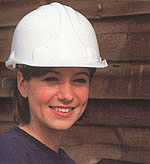Saf-T-News: October 13, 2005
Saf-T-News! This is our 205th issue, brought to you free of charge from P.S.E (Pasargad Safety Equipment).
IN THIS ISSUE...
MANAGING MOLD EXPOSURE
WHOLE LOT OF LUNG INFO
FYI: HEATING SAFETY TIPS
FYI: TOP 10 VIOLATIONS FOR 2005
MANAGING MOLD EXPOSURE
Molds are the great natural recycling agents of our planet. Give these ubiquitous little organisms enough time and moisture, and they will turn just about anything you have into a pile of dust, everything from that fruit you left out too long, to your drywall, to John Brown's body. Nothing personal, they're just doing their job.
Molds travel far and wide by producing tiny spores that drift through the air. Not surprisingly, molds turn up just about everywhere: homes, offices, schools and all kinds of public and commercial buildings. The spores settle on damp surfaces and begin to grow and digest whatever material they are on. Buildings exposed to flooding or persistent moisture are prime environments for mold. Controlling moisture is the key to controlling mold growth. To keep mold from taking hold, water-damaged areas should be dried within 24 to 48 hours.
Because molds travel by air, and because humans have to breathe air, chances are that if you're alive, you are routinely inhaling and ingesting mold spores, not to mention collecting them on your skin. This contact between mold and humans is the cause of a variety of health problems, especially for those with mold allergies.
There are no currently assigned threshold limit values (TLVs) for airborne concentrations of mold spores, nor have regulations or standards for airborne mold contaminants been established by the Environmental Protection Agency (EPA) or Occupational Safety Health and Administration (OSHA). Despite the absence of a measurable definition of the health risks posed by molds, common sense suggests that if you're working where mold is present you should take steps to prevent or reduce exposure.
PPE (personal protective equipment) may not eliminate the risk of illness or exposure, but it can help reduce it. Depending upon the potential exposure level, workers should consider wearing full-body coveralls , and respiratory protection .
When cleaning small areas of mold growth, an N95 respirator , goggles and gloves should be worn. For larger mold remediation jobs, or in situations where high levels of airborne dust or mold spores are likely or long-term exposures are expected, the EPA suggests a full-face, powered air purifying respirator (PAPR) equipped with HEPA filters along with disposable coveralls , gloves and shoe covers.
Never undertake any large mold remediation task without first receiving training from a qualified professional.
To Index
WHOLE LOT OF LUNG INFO
The super-secret government agency that decides which months will be assigned to which public health concerns has made October a twofer: Healthy Lung Month and Clean Air Month. The concurrent observances are being coordinated by the oldest voluntary health organization in the United States, the American Lung Association (ALA), still kicking after 101 years, and still working to prevent all forms of lung disease and promote lung health. To promote the October observances, the ALA has a wide range of fact sheets and other resources available on their Web site.
The National Institute for Occupational Safety and Health (NIOSH) recently published two studies that focus on work-related respiratory illnesses. The first study, Work-Related Lung Disease (WoRLD) Surveillance Report , is an update on a long range project that provides data on the occurrence rates occupational related respiratory disease. This is the sixth installment of this study. The next published version is planned for 2007.
The second study focuses specifically on the prevention of Occupational Asthma (OA) . This study combines the research of 94 different studies done between 1977 and 2003, summarizes the results found to date, and outlines which areas of research require additional attention. The NIOSH Web site gives users access to a database of these independent studies and lets them search by allergen or prevention method. This search capability lets occupational health researchers more quickly identify where gaps exist in current research.
Click here for a selection of respiratory protection products .
To Index
FYI: HEATING SAFETY TIPS
Don't look now, but winter is fast approaching. And, in case you haven't been paying any attention at all, energy prices are on the rise. As the cost of heating homes and businesses rises, so can the temptation to use auxiliary heating sources such as space heaters. While space heaters do a great job of warming up a room, they also raise the risk of fire. The NFPA (National Fire Protection Association) urges everyone to use caution when using space heaters. Click here for information on space heater safety .
To Index
FYI: TOP 10 VIOLATIONS FOR 2005
The Occupational Safety and Health Administration (OSHA) and the National Safety Council (NSC) unveiled a list of the top ten violations thus far in 2005 at the NSC Congress and Expo last month in Orlando, Florida. According to OSHA, the most frequently cited standard continues to be Scaffolding: General Requirements (1926.451) with 8,130 violations. The next most frequently cited standard remains Hazard Communication (1910.1200) with 6,641 violations.
To Index
| 
